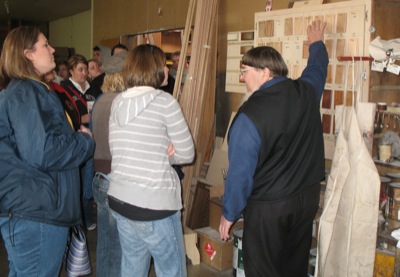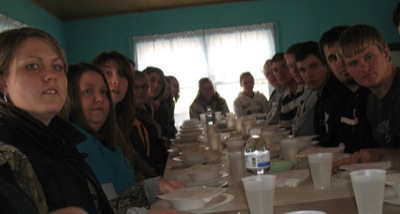Monday, March 29th, 2010
Students learn of culture just down the road
By Margie Wuebker

Photo by Margie Wuebker/The Daily Standard
Cabinet shop owner Jerome Hilty, right, talks to Wright State University-Lake Campus students during a Saturday tour as part of their "Urban Living: Amish Studies" course.
BERNE, Ind. - A group of Wright State University-Lake Campus students spent Saturday learning about a culture that enjoys a simpler life without electricity, cars and fancy clothes.
The students and their professor, Greg Homan, traveled to the Amish community near Berne, Ind., as part of the course "Urban Studies: Amish Life." Homan introduced the two-week accelerated course a year ago with 43 students registering. He pared enrollment to 32 students this year to improve the learning experience.
"College students traditionally study cultures so far away or from other eras," Homan said. "The sad thing is they don't take the time to study what is right here on our doorstep."
At Hilty Cabinets in Berne, bearded owner Jerome Hilty welcomed students and guests with a broad smile as he led the group through a series of workshops equipped with machinery powered by hydraulics and large air compressors. Heat from the machinery is harnessed to warm the place during winter months.
The business employs 12 people who produce 50 to 70 sets of custom cabinets each year, as well as bookshelves and other furniture items. A sign on the wall stating "Get it right the first time. Measure twice, cut once," serves as a reminder to all of the exacting work needed.
Ed Fox, a tour guide from the Berne Chamber of Commerce, listened to Hilty's comments before telling students "It's amazing what the Amish can do without electricity, but they have other things."
The Lake Campus group then visited Schwartz Blacksmith LLC, a family-owned business started in 1935. Ivan Schwartz, a grandson of the founder, explained it began as a horse-shoeing and buggy repair operation, eventually spawning several other businesses.
In addition to horse shoes and specialty items such as beams, posts and tent stakes, the business makes sad irons - heavy devices Amish women heat on their stoves in order to iron clothes.
Mary Schwartz, who owns Swiss Woodworking and Sales with her husband, asked the delegation how many people had been to an Amish place. She surveyed negative head shakes before responding, "We're just people like you'uns."
Schwartz runs everything but the tablesaw at the family operation, calling it "a dinky business" but all they really need. An entrepreneur in her own right, she also operates a gift shop next door specializing in wood items, as well as stamping material and classes.
She invited students to climb aboard the buggy box her husband built. Similar to other families in this part of Indiana, the Schwartzes have buckboard-style transportation instead of enclosed buggies. She laughingly admitted this is not a good time for venturing out for a ride as the horses are shedding.
Roman Schwartz had rows of chairs waiting when the group arrived for an informal lesson regarding the Amish culture dating back to the 1500s and the Reformation in Switzerland. His ancestors came to Indiana in the early to mid-1800s.
"Amish now reside in 28 states and Canada," he said. "We hold church services every two weeks and they last three hours. There is a bishop, two ministers and a deacon with the host family providing food afterward for 30 to 35 families."
Visitors toured his home from top to bottom including the laundry room, kitchen - complete with a pump for water. The basement included a long storage room for canned goods ranging from vegetable soup and spaghetti to apples and peaches. The students also enjoyed a meal served in a nearby Amish home.
Homan said he has found there are a lot of misconceptions about the Amish, and he hopes to dispel those through his course and the required research projects.
Megan Brandewie of Minster, focused her research project on the hierarchy system when hundreds of Amish show up to help build a barn. The older men get supervisory roles while youngsters attend to such things as picking up discarded items such as wood and nails.
Student George Wolfe of St. Marys, researched the way young people gather into communities of their own and progress through a rite of passage known as rumspringa.
Teri Bailey of Coldwater, discovered the difference between Old Order and New Order Amish, with the latter being more progressive than their stricter counterparts.
Homan himself took an Amish class during his college days and said he found it more interesting than others.
"I have to agree with one of the kids from the last class who wrote 'Overall the class was a great learning experience. It was like experiencing a culture hidden away from the normal day-to-day life we experience'," he said. "These are neighbors, not people living halfway around the world."

Photo by Margie Wuebker/The Daily Standard
Students eagerly await fried chicken with all the trimmings at an Amish home during a trip to the Berne, Ind., area. The tour of Amish businesses and homes concludes the accelerated class taught by associate professor Greg Homan. The class introduces students to a culture just over the state line.

